EL1 - Lecture 5 Morphology
1/74
Earn XP
Description and Tags
By Vzu Nguyen
Name | Mastery | Learn | Test | Matching | Spaced |
|---|
No study sessions yet.
75 Terms
the study of the structure and formation of words | hình thái học | _______ examines how morphemes combine to form words.
Morphology [n.] /mɔːrˈfɑːlədʒi/
the smallest unit of meaning in a language | hình vị | The word "cats" has two _______: "cat" (root) and "-s" (plural marker).
morpheme [n.] /ˈmɔːrfiːmz/
physical form that represent morphemes | hình thái | The past tense morpheme in "walked" and "jumped" is realized by different _______.
morph [n.] /mɔːrfs/
relating to morphemes | thuộc về hình vị | A _______ analysis breaks down words into their smallest meaningful parts.
Morphemic [adj.] /mɔːrˈfiːmɪk/
| relating to the study of the form of words and phrases | thuộc về hình thái học
Example: The ______ structure of English includes prefixes, suffixes, and root words.
morphological [adj.] /ˌmɔːr.fəˈlɑː.dʒɪ.kəl/
different phonetic forms of the same morpheme | biến thể hình vị | The plural morpheme in "cats," "dogs," and "horses" has three _______: /s/, /z/, and /ɪz/.
allomorphs [n.] /ˈæləˌmɔːrfs/
the phenomenon of morphemes having different phonetic forms | hiện tượng biến thể hình vị | English pluralization exhibits _______ in words like "cats" (/s/) vs. "dogs" (/z/).
allomorphy [n.] /ˌæləˈmɔːrfi/
the process of creating new words by adding affixes | sự phái sinh | The formation of "happiness" from "happy" is an example of _______.
derivation [n.] /ˌdɛrəˈveɪʃən/
the process of forming words by combining two or more roots | sự ghép từ | "Toothbrush" is formed by _______.
compounding [n.] /ˈkɑːmpaʊndɪŋ/
repeating a word or morpheme to create a new meaning | sự lặp từ | The word "bye-bye" is an example of _______.
reduplication [n.] /rɪˌduːplɪˈkeɪʃən/
changing a word's grammatical category without adding affixes | chuyển đổi từ loại | The verb "to Google" from the noun "Google" is an example of _.
conversion [n.] /kənˈvɜːrʒən/
forming a new word by merging parts of two words | sự trộn từ | "Brunch" (from "breakfast" + "lunch") is created by _.
blending [n.] /ˈblɛndɪŋ/
creating new words by cutting off part of an existing word | sự rút gọn từ | "Phone" from "telephone" is an example of _______.
shortening [n.] /ˈʃɔːrtənɪŋ/
the process of inventing completely new words | tạo gốc từ mới | "Kodak" is an example of _______.
root creation [n.] /ruːt kriˈeɪʃənz/
related to the spelling system of a language | thuộc chính tả | English has many _______ inconsistencies, such as silent letters.
Orthographic [adj.] /ˌɔːrθəˈɡræfɪk/
related to meaning in language | thuộc ngữ nghĩa | _______ change occurs when a word gains a new meaning over time.
Semantic [adj.] /sɪˈmæntɪk/
related to the sound system of a language | thuộc âm vị học | English spelling does not always reflect _______ changes.
Phonological [adj.] /ˌfoʊnəˈlɑːdʒɪkəl/
related to grammar rules | thuộc ngữ pháp | The order of words in a sentence follows _______ rules.
Grammatical [adj.] /ɡrəˈmætɪkəl/
related to sentence structure | thuộc cú pháp | Word order changes can affect _______ meaning.
Syntactic [adj.] /sɪnˈtæktɪk/
a basic unit of lexical meaning that may have different forms | từ vị | "Run," "runs," and "ran" belong to the same _______.
lexeme [n.] /ˈlɛksiːm/
the process of forming concepts from language units | sự trừu tượng hóa | "Beauty" is an example of a word formed through _______.
abstraction [n.] /æbˈstrækʃən/
a word that has the same spelling or pronunciation as another but a different meaning | từ đồng âm khác nghĩa | "Bank" (riverbank vs. financial bank) is a _______.
homonym [n.] /ˈhɒmənɪm/
a word spelled the same as another but with different pronunciation or meaning | từ đồng tự khác âm | "Lead" (to guide) vs. "lead" (a metal) are _______.
homograph [n.] /ˈhɒməɡræf/
a word pronounced the same as another but spelled differently | từ đồng âm khác tự | "Two," "to," and "too" are examples of _______.
homophone [n.] /ˈhɒməfoʊn/
related to both morphology and syntax | thuộc hình thái cú pháp | Word order and verb conjugation involve _______ properties.
morphosyntactic [adj.] /ˌmɔːrfoʊsɪnˈtæktɪk/
| the physical form of a morpheme, a concrete realization of a morpheme in speech or writing | hình vị cụ thể
Example: The word "cats" consists of two ______s: "cat" (meaning the animal) and "-s" (indicating plural).
morph [n.] /mɔːf/
a morpheme that can stand alone as a word | hình vị tự do | "Dog" is an example of a _______.
free morph [n.] /friː mɔːrf/
a morpheme that must be attached to another element | hình vị phụ thuộc | The suffix "-ing" is a _______.
bound morph [n.] /baʊnd mɔːrf/
the core morpheme of a word that carries the main meaning | gốc từ | "Act" is the _______ of "react" and "active."
root [n.] /ruːt/
a morpheme added to a root to modify its meaning | phụ tố | "-ed" in "walked" is an _______.
affix [n.] /ˈæfɪks/
affixes added at the beginning of a word | tiền tố | "Un-" in "unhappy" is a _______.
prefixes [n.] /ˈpriːfɪksɪz/
affixes added at the end of a word | hậu tố | "-ness" in "kindness" is a _______.
suffixes [n.] /ˈsʌfɪksɪz/
an affix that creates a new word with a new meaning | phụ tố phái sinh | "-er" in "teacher" is a _______.
derivational affix [n.] /ˌdɛrɪˈveɪʃənəl ˈæfɪks/
an affix that modifies a word's grammatical function | phụ tố biến cách | "-s" in "cats" is an _______.
inflectional affix [n.] /ɪnˈflɛkʃənəl ˈæfɪks/
a morpheme that attaches to a preceding word | phụ tố đi kèm | "'s" in "John's book" is an example of an _______.
enclitic [n.] /ɪnˈklɪtɪk/
specialized vocabulary of a field | thuật ngữ | Linguistics has specific _______ like "morpheme" and "phoneme."
terminology [n.] /ˌtɜːrmɪˈnɒlədʒi/
| a basic unit of lexical meaning that may have different forms | từ vị
Example: "Run," "runs," and "ran" belong to the same _______.
lexeme [n.] /ˈlɛksiːm/
| changed in form to express grammatical features such as tense, case, or number | có biến tố
Example: In English, "Finds" and "found" are ________ forms of "find".
inflected [adj.] /ɪnˈflɛktɪd/
1. Definition of Morphemes
• A morpheme is the ……………….. ……………… unit in a language. => cannot be divided further
• Like the phoneme, the morpheme refers to either a class of forms or an ……………….. from the concrete forms of language.
E.g.: TAKE (the lexeme) - takes, taking, took, taken (the word forms)
• Grammatical morphemes: a, in, can, plural morpheme, present tense morpheme.
• Lexical morpheme: book, eat, “-er”, “re-”
smallest meaningful, abstraction
1. Definition of Morphemes
Characteristics
Internally ………………… | it cannot be further subdivided or analyzed into smaller meaningful units. |
Internally ……………….. | nothing can be interposed in a morpheme |
Externally ………………… | it has positional mobility or free distribution, occurring in various context |
indivisible, stable, transportable
1.2. Types of morphemes
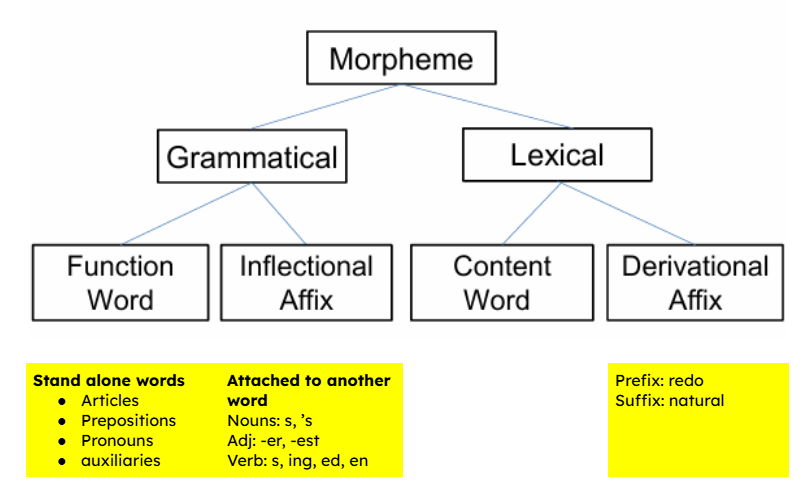
This classification is based primarily on …………………....
meaning
From your memory, regenerate the mindmap showing the types of MORPHEMES.
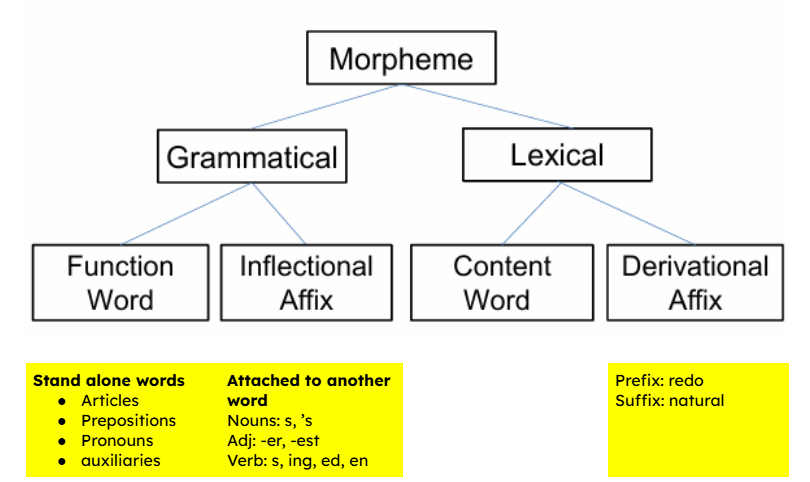
Types of morphemes comparison (fill in this table from left column to right)
Grammatical morphemes | Lexical morphemes |
Express a ………… …………. of common meanings, or express relations within the sentence. | Express ………../………meaning. |
Their occurrence is ………………….... by the grammar of the sentence. | Categorized into ……….. ………..: noun, verb, adjective, adverb |
Constitute ………… word classes. Can be exhaustively ………….. . | Constitute ……. categories i.e. new members can be ………. |
Are ……...... ….. …..….. i.e. inflectional affixes, or small but ……………….. ‘function words’ belonging to the minor word classes i.e. prepositions. | Are generally ……………… words (free roots) or ………. of words (derivational affixes and bound roots). |
limited number, predictable, closed, listed, parts of words, independent, lexical, dictionary, word classes, open, added, independent, parts
Examples of morphemes
____________ morphemes | __________ morphemes |
|
|
|
- Prefixes: eg. re-, un- , dis- - Suffixes:
|
Grammatical, Lexical
Morpheme versus morphs
Morphemes are represented within _______ braces { }.
HINT: Like the phoneme, the morpheme refers to either a class of forms or an abstraction from the concrete forms of language. For example, the feminine morpheme is an abstraction which can be realized in a number of different ways, by -ess, as in actress, or by a personal pronoun such as she. Because morphemes are abstractions we place them within curly braces { } using capital letters for lexemes and descriptive designations for other types of morphemes. For actress, the morphemes are {ACTOR} and {f} (for {feminine]).
curly
Morpheme versus morphs
1. Definition of Morphs
• A morph is the 1. …………………… realization of a morpheme. (sometimes although we know that a morpheme exists, it has no 1……………… realization, Eg: Fish: {fish} + {pl} (i.e. the singular and plural forms of fish are both pronounced /fI∫/) )
• This classification is based primarily on 2. ……………………….

concrete, form
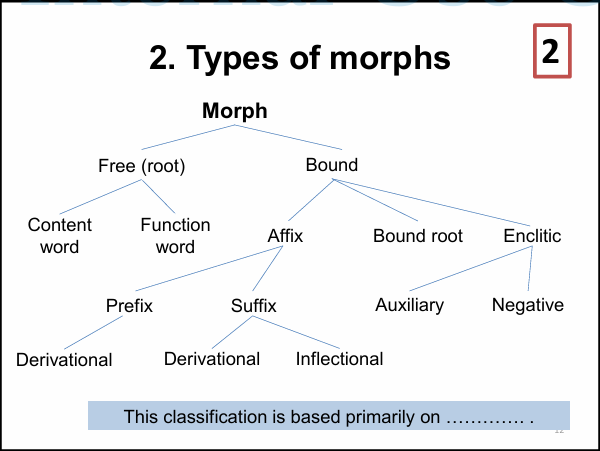
form
From your memory, regenerate the mindmap showing the types of MORPHS.
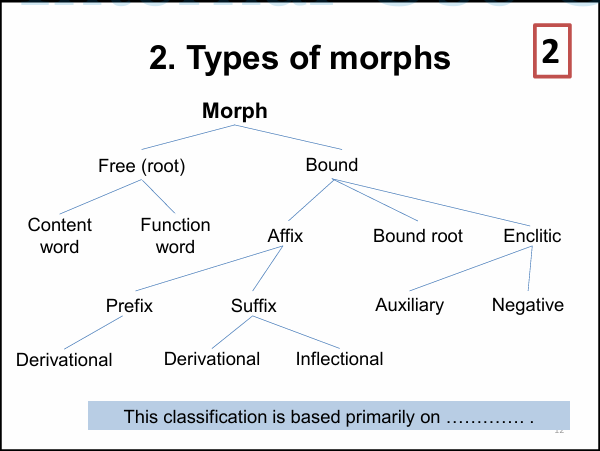
TYPES OF MORPHS (fill in this table from left column to right)
Free morphs | Bound morphs |
Can stand by themselves as ………………… words. | Cannot normally stand alone and are always ………………….. another morph. |
Is always a ……… morpheme. | |
Carries the principal lexical or grammatical ………………… . | Doesn’t carry the ……………. meaning. |
E.g. open, tour, unavoidably | E.g. re-, -ist, -ed, -s, -’s |
May …………… ………… other free or bound morphemes. E.g.: unavoidably, overgrown, Disheartened, reclassify | …………….. are occasionally bound morphs (or bound roots). (foreign borrowings that were free in the source language, but not free in English) E.g.: 5 -ject- inject, reject 6. -rupt (=break) = disrupt, erupt 7. -fer (=carry/bring): transfer, confer 8. -gress (=step,go): progress, regress, disgress 9. -duce/-duct (lead): introduce, conduct,reduce 10. -tain (hold): contain, retain 11.-spect (look): inspect, respect 12. - scribe/-script (write): describe, prescribe  |
single, root, meaning, attach to, attached to, core, roots
TYPES OF AFFIXES (fill in this table from left column to right)
Derivational affixes | Inflectional affixes |
Can either be a ……….. or ………... | Is always a ……….. . |
Can be …….. ………. …….. ~ per word. | only …….. ~ per word. |
A particular ~ may attach to only a ………. number of roots. | A particular ~ may attach to ……. …. ……… members of a certain word class ( part of speech). |
Function: - Convert one …….. …… ……….. to another (e.g., noun to verb). - Change the ……….. of the root but keep their word class ( e.g., happy (adj) → unhappy (adj) ). | Function: - Indicate the …….……….. …………….. of a word. |
Always ………. an inflectional affix. | always occur ………… |
prefix, suffix, more than one, limited, part of speech, meaning, precede, suffix, one, all or most, grammatical meaning, last
criteria for inflectional suffixes:
Criterion | Explanation | Examples |
(a) …….. ……… the part of speech of a root | Inflectional suffixes do not alter the grammatical category (noun, verb, adjective, etc.) of a word. Instead, they only modify grammatical features such as tense, number, case, or degree. | - Noun → Noun: cat → cats (plural) (N remains N) - Verb → Verb: walk → walked (past tense) (V remains V) - Adjective → Adjective: tall → taller (comparative) (Adj remains Adj) |
(b) …………, not precede, any derivational suffixes | When a word has both derivational and inflectional suffixes, the derivational suffix must be attached first, and then the inflectional suffix is added. | - Derivational suffix (-ness) first, then inflection (-’s): → kind (Adj) + -ness → kindness (N) + -’s → kindness’s (possessive) - Incorrect Order: kind’sness ❌ |
(c) Affix to virtually any member of the category …………. | Inflectional suffixes apply broadly to most words in a category, rather than being selective like derivational morphemes. | - Comparative (-er) applies to most adjectives: → big → bigger, small → smaller, fast → faster - Superlative (-est) applies to most adjectives: → happiest, tallest, smartest - Irregular exceptions exist but do not disprove the rule: (good → better, bad → worse). |
Additional Notes
Inflectional suffixes (like -s, -ed, -ing, -er, -est) do not create new words; they only modify grammatical properties.
Derivational suffixes (like -ness, -ment, -able, -ize) often change part of speech and must be attached before inflectional ones.
Inflectional suffixes are highly productive, meaning they apply to most words in a category, unlike derivational suffixes, which are more selective.
Aspect
Inflectional Suffixes (Not Selective)
Derivational Suffixes (Selective)
Definition
Apply broadly to most words in a category.
Apply only to specific words in a category.
Example Suffixes
-s (plural), -ed (past tense), -ing (present participle), -er (comparative), -est (superlative)
-ness (adjective → noun), -ment (verb → noun), -ity (adjective → noun)
Works with Almost Any Word in Category?
✅ Yes, e.g., fast → faster, book → books, jump → jumped
❌ No, only some words accept them, e.g., happy → happiness but not intelligent → intelligentness
Example 1
Plural (-s): dog → dogs, book → books, car → cars (applies to most countable nouns)
"-ness" (adj → noun): kind → kindness, but ❌ intelligent → intelligentness
Example 2
Comparative (-er): tall → taller, bright → brighter, fast → faster (applies to most adjectives)
"-ment" (verb → noun): develop → development, but ❌ run → runment
Flexibility
Very flexible—can be used with nearly all words in a category.
Limited—works only with specific words.
never change, follow, adjective
TYPES OF MORPHS
……………… Inflections | ……………… inflections |
Attach to any new word entering the language to express a particular grammatical category. There are only 8 inflections of this kind Eg:
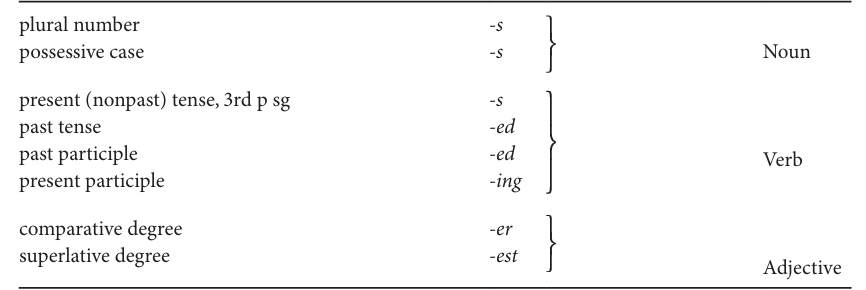 | Never attach to a new word Are found on select members of a class eg.: • Plural vowel alteration: tooth -teeth • most superlative of foremost • en past participle: write - written • Past tense vowel alteration: sing - sang |
productive, nonproductive
Types of morphs
• An encliticis a kind of …………………., a bound form which derives from an ……………… word and must be attached to the preceding word.
• Two kinds of enclitics:
– ………………. : attached to the preceding subject (He’ll, she’d, I’ve, You’re, I’m)
– …………….–n’t: attached to the preceding auxiliary (won’t, mustn’t, hasn’t, wasn’t) 16 This classification is based primarily on MEANING.
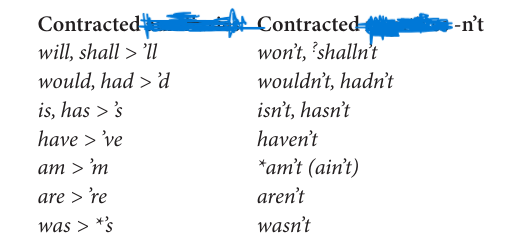
contraction, independent, auxiliaries, negative
Type of Word | Definition | Characteristics | Examples |
………….. Word | Contains one free root with no bound morphemes. | - Cannot be broken down further morphologically. - Can function as a complete word on its own. | hand, dog, run, bright |
…………Word | Contains a free root + one or more bound morphemes OR only bound morphemes. | - Can be formed by adding derivational or inflectional affixes. - Some complex words consist only of bound morphemes. | - Free root + bound morpheme: unhand, handy, handful- Bound morphemes only: transference, reception, conversion |
…………….Word | Contains two free roots combined into one word. | - Can be written as one word, hyphenated, or separate words. - The meaning may be predictable or idiomatic. | handbook, handrail, handgun, sunflower |
……….-………….. Word | Contains two free roots + associated bound morphemes. | - Formed by adding derivational affixes to a compound word. - More morphologically complex than regular compounds. | handwriting, handicraft, dishwasher |
simple, complex, compound, compound-complex
A Root ≠ | A Base, which is a ……….. + associated derivational affixes, to which ……………… …………… are added. | |
A Stem, which is a ………… + associated derivational affixes, to which …………… ……………… are added. | ||
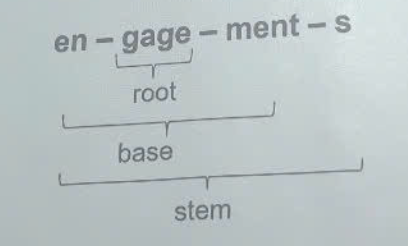
ROOT, derivational affixes, ROOT, inflectional affixes
Morphemic analysis vs. Morphological analysis
• Not always a …………………… correspondence between morph and morphemes.
• Morphemes can combine or be realized in a number of different ways:
Morphological analysis: words are analyzed into …………….. (following formal divisions).
Morphemic analysis: words are analyzed into …………………. (recognizing the abstract units of meaning present).
Let’s have a look at how these analyses work in nouns, adjectives, verbs, etc.:
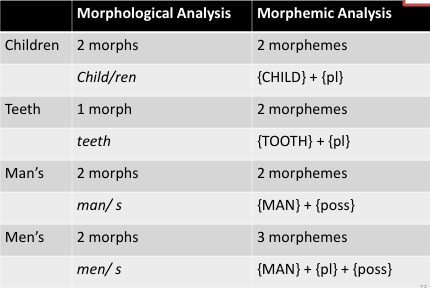
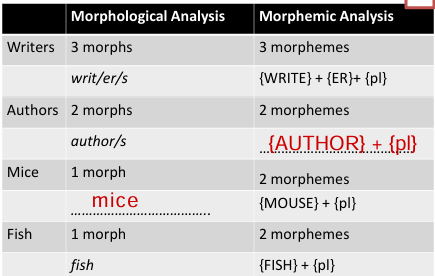
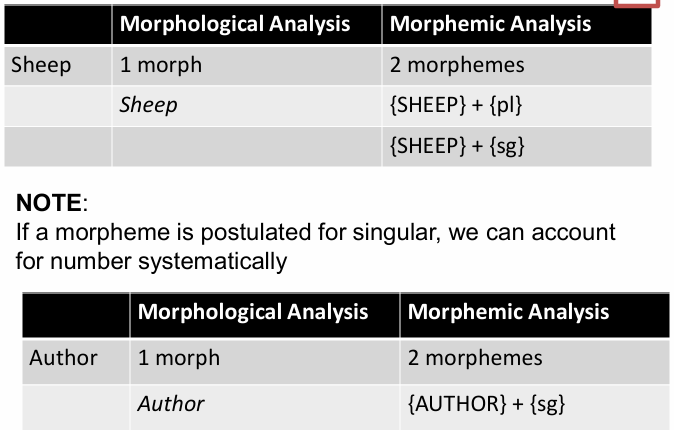
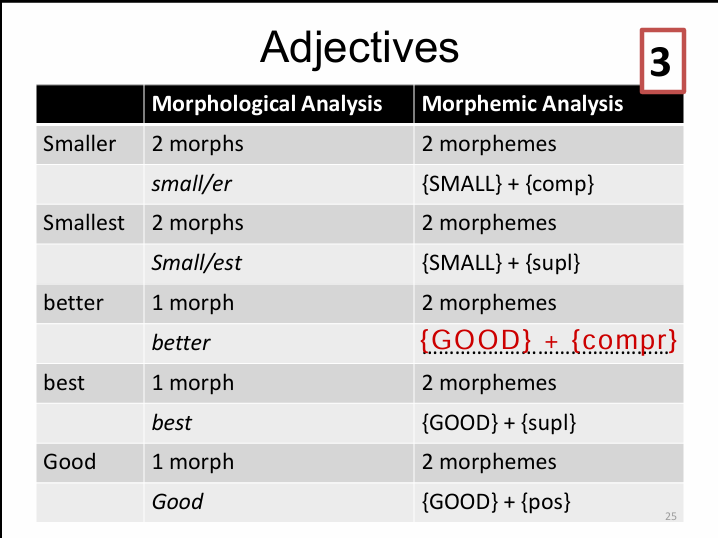
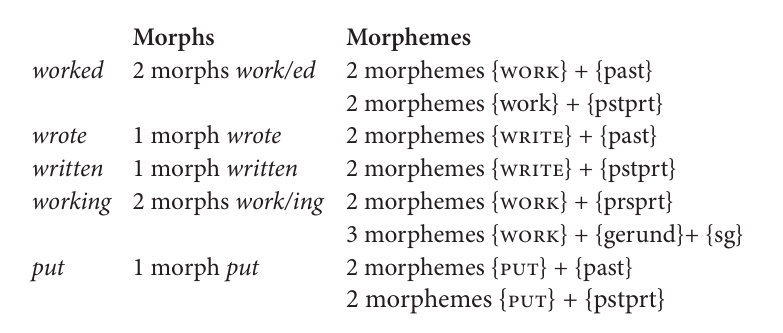



List of abbreviations for analysis:
{pl}: plural;
{sg}: singular,
{poss}: possessive;
{compr}: comparative degree;
{pos}: positive degree;
{supl}: superlative degree;
{m}: masculine gender,
{f}: feminine gender,
{n}: neuter gender,
{pres}: present tense;
{past}: past tense;
{prsprt}: present participle,
{pstprt}: past participle;
{nomn}: nominative case;
{Obj}: objective case;
{gerund}: gerund;
{1rd/ 2nd/ 3rd p}: first/second/third person
one-to-one, morphs, morphemes
| the grammatical case used for the subject of a sentence | cách chủ cách
Example: In the sentence "She runs every morning," "she" is in the ______.
nominative case: we, he, they
Nominative case [n.] /ˈnɒm.ɪ.nə.tɪv keɪs/
| the grammatical case used for the object of a verb or preposition | cách túc cách
Example: In the sentence "I saw him yesterday," "him" is in the ______.
Object of a sentence: us, him, them, her
Objective case [n.] /əbˈdʒɛk.tɪv keɪs/
| a morphological rule where words are formed by stringing together distinct morphemes, each representing a single grammatical meaning | quy tắc chắp dính
Example: In an ______ language, each morpheme retains its meaning and pronunciation clearly.
ex: {WRITER} + {pl} → writers
{WORK} + {past} → worked
Agglutinative rule [n.] /əˈɡluː.tɪ.nə.tɪv ruːl/
| a morphological rule where a single morpheme conveys multiple grammatical meanings simultaneously | quy tắc hòa kết
Example: Latin is an example of a language that follows the ______, where case and number are fused in a single morpheme.
ex:
{TOOTH} + {pl} → teeth
{WRITE} + {past} → wrote
Fusional rule [n.] /ˈfjuː.ʒən.əl ruːl/
| a morphological rule where a grammatical feature is expressed without an overt morpheme | quy tắc hiện thực hóa rỗng
Example: The plural form of "sheep" follows the ______ because there is no visible plural marker.
ex:
{WORK} + {sg} → work
{DOG} + {sg} → dog (no suffix for singular)
Null realization rule [n.] /nʌl ˌrɪə.laɪˈzeɪ.ʃən ruːl/
| a morphological rule where a grammatical distinction is indicated without any phonetic change | quy tắc số không
Example: In English, some nouns follow the ______, where singular and plural forms are identical, such as "deer."
Ex:
{SHEEP} + {pl} → sheep (while most other nouns take -s for plural)
Zero rule [n.] /ˈzɪə.rəʊ ruːl/
MORPHOLOGICAL REALIZATION RULES
Fill in the blanks with appropriate words to complete the descriptions of the morphological realization rules (from left column to right).
Morphological Realization Rule | Description | Example |
|---|---|---|
Agglutinative rule | Two morphemes are realized by morphs that remain distinct and are simply '_________' together. | {WRITER} + {pl} → writers {WORK} + {past} → worked |
Fusional rule | Two morphemes are realized by morphs that do not remain __________ but are __________ together. | {TOOTH} + {pl} → teeth {WRITE} + {past} → wrote |
Null realization rule | A morpheme is never realized as a __________ in any word of the relevant class. e.g. {sg} on nouns, which never has a concrete realization in English. | {WORK} + {sg} → work {DOG} + {sg} → dog (no suffix for __________) |
Zero rule | A morpheme is realized as a __________ morph in particular members of a word class. Note that in most other members of the class noun, {pl} has a concrete realization as -s | {SHEEP} + {pl} → sheep (while most other nouns take -s for plural) |

glued, distinct, fused, morph, zero, singular
1. Definition of Allomorphs
• Allomorphs are ………………… variants of morphemes. (just like allophones to phonemes)
• Allomorphs are:
Characteristic | Explanation | Examples |
|---|---|---|
………………… similar | Allomorphs of a morpheme retain the same core meaning despite their different forms. | The plural morpheme -s in English has different pronunciations but still means "more than one": - cats /s/ - dogs /z/ - buses /ɪz/ another example: • The plural morpheme in English '-s'. '-s' is the morpheme, but the morph changes in different words: Cats - '-s' morpheme is pronounced /s/ Dogs - '-s' morpheme is pronounced /z/ Houses - '-s' morpheme is pronounced /IZ/ |
In ……………….. distribution | Each allomorph appears in a specific phonological or grammatical environment and does not overlap with the others. | The past tense morpheme -ed is pronounced differently depending on the preceding sound: - walked (/t/ after voiceless sounds) - grabbed (/d/ after voiced sounds) - wanted (/ɪd/ after /t/ or /d/) |
….. necessarily phonologically similar | Some allomorphs look and sound quite different but still represent the same morpheme. | The plural form of nouns in English: - ox → oxen - child → children - sheep → sheep (zero allomorph) |
predictable, semantically, complementary, not
Allomorphs are predicted in one of the three ways:
Type of Conditioning | Explanation | Examples |
|---|---|---|
………………… conditioned | The choice of allomorph is determined by the sounds (phonetic environment) surrounding it. | English plural -s changes depending on the final sound of the noun: - /s/ after voiceless sounds: cats (/kæts/) - /z/ after voiced sounds: dogs (/dɔgz/) - /ɪz/ after sibilants: buses (/bʌsɪz/) English past tense -ed also follows phonological rules: - /t/ after voiceless sounds: walked (/wɔːkt/) - /d/ after voiced sounds: grabbed (/ɡræbd/) - /ɪd/ after /t/ or /d/: wanted (/wɒntɪd/) |
………………. conditioned | The choice of allomorph depends on grammatical rules, not phonetics. | Plural formation in English: - goose → geese (not gooses) - child → children - sheep → sheep (zero allomorph) Past tense in irregular verbs: - go → went - is → was / are → were 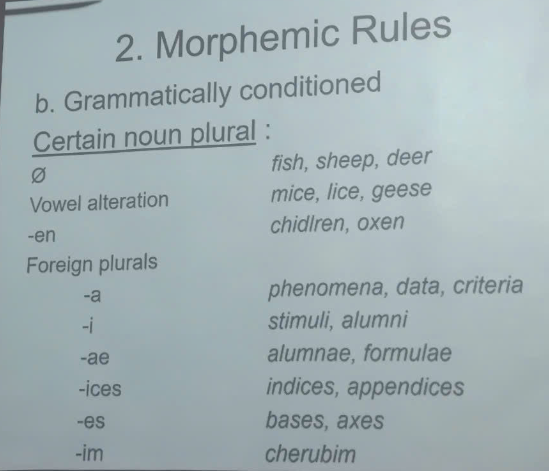 |
……….. …………. | The choice of allomorph is not phonologically or grammatically determined; speakers can use them interchangeably. | British vs. American pronunciation of past participles: - learned vs. learnt - burned vs. burnt Different pronunciations of "either" and "neither": - /ˈaɪðər/ vs. /ˈiːðər/ |
Summary
Phonologically conditioned allomorphs depend on sound patterns.
Grammatically conditioned allomorphs follow language rules but are not predictable by sound.
Free variation allows interchangeable usage.
phonologically, grammatically, free variation
2. Morphemic Rules
?How are these allomorphs conditioned?
Determining factor:
The ………. ……….. of the root of the noun
A: Fricative or affricate (sibilants)=> [əz]
B: voiceless consonant => [s]
C: voiced sound or vowel => [z]
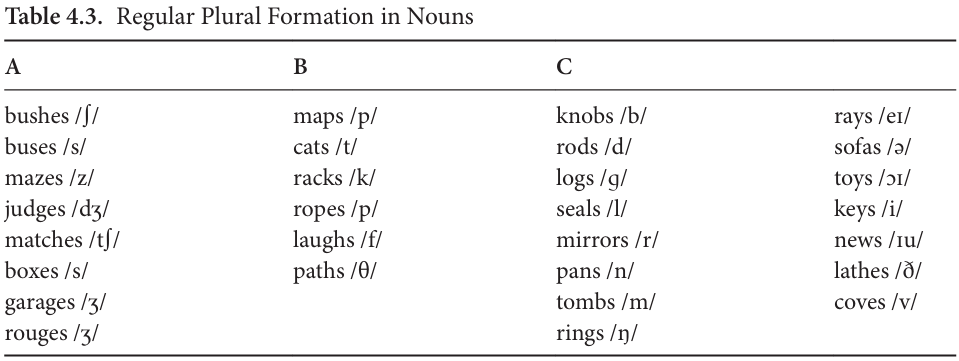
final sound
2. Morphemic Rules
…………………. conditioned
A morpheme can have different pronunciations (allomorphs) depending on surrounding sounds. This variation is not random but follows phonological rules of a language.
For example, the English plural morpheme "-s" has three different pronunciations (allomorphs):
/s/ after voiceless sounds (cats /kæts/)
/z/ after voiced sounds (dogs /dɒgz/)
/ɪz/ after sibilant sounds (buses /ˈbʌsɪz/)
However:
Certain …………. sounds change pronunciation when forming plurals.
Some fricatives take the /s/ plural (e.g., roof → roofs /ruːfs/).
Others take the /z/ plural (e.g., knife → knives /naɪvz/).
Examples of Fricative Changes in Plurals
Singular (with [f] or [θ]) | Plural (with [v] or [ð]) | Plural Pronunciation |
|---|---|---|
knife /naɪf/ | knives /naɪvz/ | [z] allomorph, fricative shifts to [v] |
wolf /wʊlf/ | wolves /wʊlvz/ | [z] allomorph, fricative shifts to [v] |
loaf /loʊf/ | loaves /loʊvz/ | [z] allomorph, fricative shifts to [v] |
thief /θiːf/ | thieves /θiːvz/ | [z] allomorph, fricative shifts to [v] |
bath /bæθ/ | baths /bæðz/ | [z] allomorph, fricative shifts to [ð] |
However, some fricatives stay the same:
Singular (with [f]) | Plural (keeps [f]) | Plural Pronunciation |
|---|---|---|
roof /ruːf/ | roofs /ruːfs/ | [s] allomorph, no change |
cliff /klɪf/ | cliffs /klɪfs/ | [s] allomorph, no change |
chief /tʃiːf/ | chiefs /tʃiːfs/ | [s] allomorph, no change |
Phonologically, fricative
(a) Morphemic Rules: Regular Plural, 3rd Person Singular, and Possessive Morphemes
In English, the plural noun morpheme (-s), the 3rd-person singular present verb morpheme (-s), and the possessive morpheme (-’s) follow a phonological pattern depending on the ………. ……….. of the word.
These morphemes have three different pronunciations (allomorphs), determined by the final sound of the base word.
1. The Three Allomorphs of "-s" and Their Distribution
Allomorph | Phonetic Representation | Used When the Base Word Ends in... | Examples |
|---|---|---|---|
/ɪz/ or /əz/ | Sibilant consonants ([s], [z], [ʃ], [ʒ], [ʧ], [ʤ]) | buses, watches, bridges | |
/s/ | Voiceless consonants ([p], [t], [k], [f], [θ]) | cats, books, cliffs | |
/z/ | Voiced sounds (vowels and voiced consonants, except sibilants) | dogs, pens, keys |
2. Explanation of Each Allomorph (1) [əz] /ɪz/ → After Sibilants
Sibilants are hissing or hushing sounds: [s], [z], [ʃ], [ʒ], [ʧ], [ʤ].
If a word ends in a sibilant sound, adding a simple /s/ or /z/ would be difficult to pronounce, so English inserts an extra vowel sound (/ɪz/ or /əz/) for ease of articulation.
🔹 Examples:
Plural nouns: bus → buses (/bʌsɪz/), watch → watches (/wɒtʃɪz/)
3rd person singular verbs: miss → misses (/mɪsɪz/), wash → washes (/wɒʃɪz/)
Possessives: James → James’s (/dʒeɪmzɪz/)
(2) [s] → After Voiceless Consonants
Voiceless consonants are sounds produced without vocal cord vibration: [p], [t], [k], [f], [θ].
After a voiceless sound, the morpheme is pronounced as /s/ to maintain voicing agreement.
🔹 Examples:
Plural nouns: cat → cats (/kæts/), book → books (/bʊks/)
3rd person singular verbs: talk → talks (/tɔːks/), laugh → laughs (/læfs/)
Possessives: Jeff → Jeff’s (/dʒɛfs/)
(3) [z] → After Voiced Sounds (Elsewhere Case)
Voiced sounds include vowel sounds and voiced consonants (except sibilants).
When the word ends in a voiced sound, the morpheme is pronounced as /z/ to match the voicing of the final sound.
🔹 Examples:
Plural nouns: dog → dogs (/dɒgz/), pen → pens (/pɛnz/)
3rd person singular verbs: run → runs (/rʌnz/), play → plays (/pleɪz/)
Possessives: John → John’s (/dʒɒnz/)
3. Why Does This Happen? (Phonological Explanation)
The choice between [s] and [z] follows a voicing assimilation rule:
If the preceding sound is voiceless, the /s/ sound is used to maintain consistency.
If the preceding sound is voiced, the /z/ sound is used for smoother pronunciation.
For the [əz] case, an extra vowel sound is inserted because two sibilants together are hard to pronounce.
4. Summary Table
Final Sound of the Word | Type of Sound | Allomorph Used | Example (Singular → Plural / 3rd Person Singular / Possessive) |
|---|---|---|---|
s, z, ʃ, ʒ, ʧ, ʤ | Sibilants | /ɪz/ | bus → buses, watch → watches, James → James’s |
p, t, k, f, θ | Voiceless consonants | /s/ | cat → cats, talk → talks, Jeff → Jeff’s |
All other voiced sounds (vowels, b, d, g, v, m, n, l, r, etc.) | Voiced sounds | /z/ | dog → dogs, run → runs, John → John’s |
final sound
Morphemic Rules:
(b) Grammatically Conditioned
1. Grammatically Conditioned Allomorphy
1.1 Irregular Plurals in English
Unlike regular plural nouns, which simply take -s/-es (e.g., cats, dogs, buses), some nouns do not follow this pattern and instead undergo special root changes or use borrowed plural forms from other languages.
These plurals are ……………….. conditioned because their forms are dictated by morphological and historical patterns, not phonological rules.
Plural Formation Type | Example Singular | Example Plural |
|---|---|---|
Ø (Zero Plural) | fish, sheep, deer | fish, sheep, deer (same form in singular and plural) |
Vowel Alternation | mouse, louse, goose | mice, lice, geese (internal vowel change) |
-en Plurals | child, brother, ox | children, brethren, oxen |
Foreign Plurals | (borrowed from Latin, Greek, Hebrew, etc.) | (various suffixes based on original language rules) |
Foreign Plural Forms and Examples
These forms originate from Latin, Greek, or Hebrew and are not productive, meaning they do not apply to new words in English.
Suffix | Example Singular | Example Plural | Language Origin |
|---|---|---|---|
-on → -a | phenomenon | phenomena | Greek |
-um → -a | datum | data | Latin |
-us → -i | stimulus | stimuli | Latin |
-is → -es | basis | bases | Greek |
-ex/-ix → -ices | index | indices | Latin |
-ae | alumna | alumnae | Latin |
-im | kibbutz | kibbutzim | Hebrew |
1.2 Why Are These Endings Not Productive?
Productive rules in morphology apply to new words. For example, we can form the plural of laptop as laptops, because the -s rule is productive.
However, we do not say:
❌ mouse → mouses
❌ child → childs
Instead, these words retain their irregular plural forms due to historical development
BUT possessive Morpheme (-’s) Stays …………..
Even when nouns have irregular plural forms, the possessive -’s remains consistent in pronunciation:
Singular Noun | Possessive Form |
wolf (/wʊlf/) | wolf’s (/wʊlfs/) |
knife (/naɪf/) | knife’s (/naɪfs/) |
house (/haʊs/) | house’s (/haʊsɪz/ or /haʊsəz/) |
=> 2 predictable variants of the roots, called …….. ……………..
This means that while some nouns have irregular plural changes, their possessive forms follow the regular possessive pattern.
grammatically, regular, root allomorphs
(b) grammatically conditioned
Root Allomorphy: Singular vs. Plural Conditioning
The 2 allomorphs of the root are grammatically conditioned by the presence of either a following {sg} or {pl} morpheme. In other words, some words have two allomorphs of their root, depending on whether the word is singular or plural.
Example: life → lives
{lif} (root morpheme)
[liv]/ -{pl} (before a plural morpheme) → lives (/laɪvz/)
[lif]/ elsewhere (singular, possessive) → life (/laɪf/), life’s (/laɪfs/)
This alternation is ……………… conditioned because the plural morpheme triggers the change.
grammatically
| word forms that function as nouns, including nouns, pronouns, and nominalized words | các dạng danh từ
Example: In the sentence "Reading is enjoyable," the word "reading" is in its ______.
Nominal forms [n.] /ˈnɒm.ɪ.nəl fɔːmz/
| word forms that function as verbs, including finite and non-finite verb forms | các dạng động từ
Example: In the sentence "She wants to swim," the word "swim" is in its ______.
Verbal forms [n.] /ˈvɜː.bəl fɔːmz/
(b) grammatically conditioned
Other root allomorphy
Noun → Verb (Root Alternations)
Some words undergo consonant alternation when switching from noun (………….. from) to verb (…………. form).
(a) [s] → [z] Alternation
Noun → Verb pairs where [s] changes to [z]
house (/haʊs/) → to house (/haʊz/)
use (/juːs/) → to use (/juːz/)
(b) [θ] → [ð] Alternation
Noun → Verb pairs where [θ] changes to [ð]
bath (/bæθ/) → to bathe (/beɪð/)
breath (/brɛθ/) → to breathe (/briːð/)
This alternation is grammatically conditioned because the change only happens when the word functions as a verb.

nominal, verbal
c) ………………… Conditioned Allomorphy
The Definite Article "The" ([ðə] vs. [ði]
The pronunciation of "the" changes based on the following word’s phonetic environment.
Form of "The" | Used Before... | Example |
[ðə] (/ðə/) | Consonant sounds | the book (/ðə bʊk/), the table (/ðə ˈteɪbəl/) |
[ði] (/ði/) | Vowel sounds | the apple (/ði ˈæpəl/), the elephant (/ði ˈɛlɪfənt/) |
🔹 Why?
This alternation happens for ease of pronunciation:
[ðə] before consonants makes speech smoother.
[ði] before vowels avoids difficult consonant clusters.
Contextually
Function words:
………….. (he, she, it, they, them,….)
…………… (in, on, at, to,….),
………… verbs,
……………. (for, and, nor, but,……),
…………….. (articles, possessives, demonstratives, quantifiers, numbers, ordinals, interrogative determiners - which/what)
pronouns, prepositions, auxiliary, conjunctions, determiners